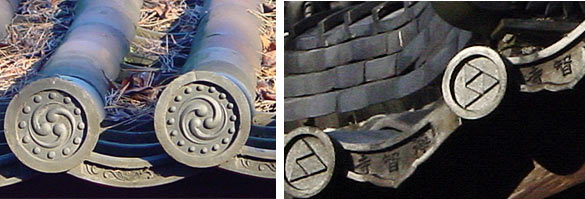| Patterns,
motifs, designs applied to the circular antefixes *gatou
瓦当 on semi-cylindrical eave-end tiles *nokimarugawara
軒丸瓦 and to the pendant bands added to broad, concave eave-end tiles *nokihiragawara
軒平瓦. From the 7c-11c, the most popular motifs decorating the antefixes
of semi-cylindrical eave-end tiles were variations of stylized lotus patterns
*rengemon 蓮華文.
Patterns on the pendant bands of broad, concave eave-end tiles were mainly
arabesques *karakusamon
唐草文 based on stylized vines, one example being honeysuckle *nindou
karakusamon 忍冬唐草文, which were generally symmetrically arranged
around a central curvilinear motif. Occasionally the arabesque was a continuing
pattern with no central motif *henkou
karakusamon 扁行唐草文. A grape pattern tile *budou
karakusamon 葡萄唐草文, dated late 7c, was unearthed at Okadera 岡寺,
in Nara. Although these motifs were continued into and beyond
the 12c, generally their use declined. New motifs began to replace the old
lotus and arabesque patterns. The comma pattern *tomoemon
巴文 was used most frequently on the pendant disks of semi-cylindrical tiles
but less often on the pendant bands of the broad, concave, eave-end tiles.
For an example of the comma pattern on the broad, concave eave-end tile
(mid-10c) unearthed at Byoudouin 平等院, Kyoto. Other popular motifs from
the 11c were patterns of Budhist ritual implements *sankoshomon
三鈷杵文, stylized sword tips *kentoumon
剣頭文, tiles embellished with the temple's name, Sanskrit characters *bonjimon
梵字文, and from the 16c on, particularly on castles and palaces, family crests.
Family crests decorated both the semi-cylindrical and broad concave eave-end
pendants and pendant bands *monjigawara
文字瓦. One example is the paulownia crest kirimon 桐文 used on both
types of tiles unearthed at the site of Fushimijou 伏見城,
in Kyoto. |




